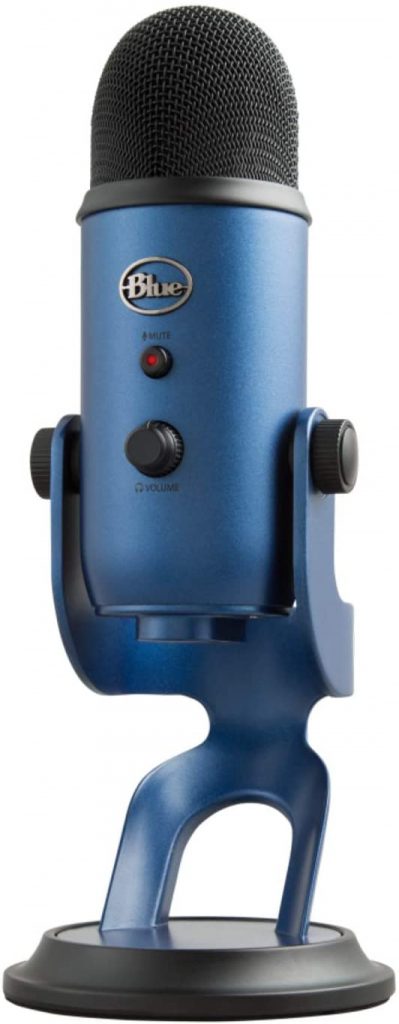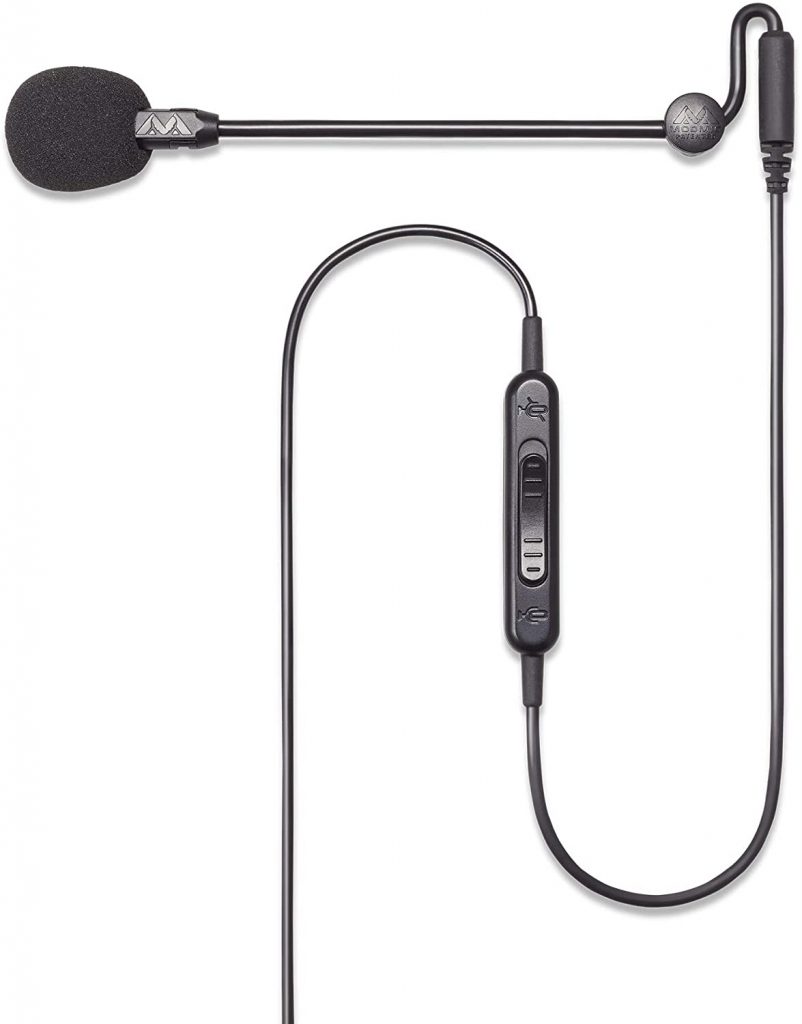If you are in the market for a new mic you would have heard about the Blue Yeti or the Modmic. Both are really good mics that produce quality sound but where do you invest your money?
We are here to help you figure it out. Below we take a look at both mics and go over their pros and cons. Let’s jump right into it.
Table of Contents
Blue Yeti USB
The Blue Yeti is a very popular choice for a lot of people. It comes in at around $130 making it an affordable option. But what makes this mic special is that it’s extremely versatile. It provides a lot of options to record audio in different environments. Let’s first take a look at the hardware.
Blue Yeti Hardware Overview
The Blue Yeti USB is a very solid device and comes in as one of the heavier mics. The stand Yeti comes with is also nice and solid, allowing for the mic to be placed in various configurations. The base is padded with rubber ensuring that it has a firm grip on the surface it is placed on.
There are also multiple color options that the Blue Yeti comes in making it a good choice for streamers or anyone wanting a mic that suits their existing setup.
This mic also has a 3.5mm headphone jack for Zero-latency transmission, a feature that is a must for anyone looking to capture good audio.
There are a few other knobs and switches on the mic, one for the gain control, and the other is a very handy mute button. These features make recording audio on the go extremely easy as corrections can be made in person rather than having to fix it in post.
There are volume control knobs as well.
Blue Yeti Software Overview
The Blue Yeti USB mic is easy to set up and use, it is as simple as plug and play. It has support for both Windows and Mac operating systems.
this means that there is no need to install any new drivers as it uses only the pre-installed ones.
The Blue Yeti USB mic also has its software called the Blue Sherpa which gives you the ability to install firmware updates.
It also allows you to control audio settings like gain, volume, headphone volume, and mute on the go.
Blue Yeti Sound Overview
The Blue Yeti has four different recording modes that capture audio in different ways.
- Omnidirectional
- Bidirectional
- Cardioid
- stereo
Omnidirectional
The omnidirectional mode captures audio from all the directions. Meaning that the mic is sensitive to noise from all around. This however will reduce the quality of the overall sound. This mode should be used in an environment such as a group discussion or meeting.
In these situations, it is more important to have captured the voices and sounds of all the participants gathered around rather than focus on the sounds from a particular area.
Bidirectional
Bidirectional mode captures audio from two opposite ends of the microphone and ignores any noise coming from the sides. This mode is especially useful when you have to record an interview.
If you are looking into doing a lot of interview type recording we recommend you opt for a dual-mic setup. Singular mics can get the job done but if you are looking for a truly professional option having a dual mic setup would be the way to go.
Cardioid
The cardioid recording pattern is the default one and is the one that you might use most often. In the cardioid mode, the focus is on picking up sound from the front and ignoring the sounds from the back of the microphone.
It is perfect for podcasting, streaming, webinar sessions, or even doing voice overs for your videos.
Stereo
This mode captures audio in a way where you have good separation between audio from the right channel and audio from the left channel. People usually prefer this mode when they record some form of acoustic audio like from instruments.
General Overview
The audio quality that the Blue Yeti USB mic outputs is really good so much so that it can match studio quality, in the right surroundings.
There have been some complaints, however, with regards to the mic auto muting itself during sessions. This is not a widespread problem but has happened to some users in the past.
Also, the mic does tend to pick up background noise and can hamper the overall quality of the output. This is mostly in cases where you try to record instruments in stereo mode.
The frequency range for the microphone is 20Hz – 20kHz which covers the hearing range for humans. This allows us to capture very fine audio as well.
The audio is also sampled at a rate of 16bits ensuring that audio sound crisp.
Although these issues are not deal breakers it is good to keep them in mind. In the end, it comes down to your use case to see if this mic is a fit for you.
Modmic
Modmics are especially useful if you are looking for gaming-centric microphones. They are extremely versatile and output great audio quality. They also come in cheaper than the Blue Yeti USB mic. A normal pair of modmics can cost you anywhere between $50-$100 making it a bargain when compared to the Blue Yeti.
Modmics provide true portability and as they can turn any pair of good headphones into headsets. It’s sometimes disappointing to see a great pair of headphones not have an integrated mic system, that’s where modmics come in.
Modmic Hardware Overview
Modmics are compact and can only be easily integrated into any setup. Setting them up also is as easy as plug and play with no need to install additional drivers.
These mics can easily be stowed away when not required making them extremely modular as the name suggests.
These mics can also be integrated with many accessories that enhance either the quality of sound or eases the integration into the setup.
These accessories can be things like extension cables, hardbound cases, or even pop filters to help with the audio output.
Modmic Software Overview
There is no special software that is required to interface with these mics. They all have a simple plug and play mechanism making them a good choice for beginners to use in their setups.
Modmic Sound Overview
Modmics can be used in a versatile environment and situations because of their compact nature. But they generally have only a singular audio profile namely, the unidirectional mode.
In the unidirectional mode as explained above only audio that comes from one end of the microphone is picked up and sounds from the other areas are ignored.
This usually comes in handy while streaming, where only the voice of the host should be recorded and kept in focus.
So the modmic bests the Blue Yeti in one way as it does not pick up any background noise.
Also, the frequency range is from 100 Hz–10 kHz which does not cover the entire range of human hearing. So if you’re going to use this mic to do very fine audio editing, you might miss out on some clips.
These are however extreme cases and will not hamper day to day use for things like voiceovers or streams.
Final Thoughts
Modmics provide great audio quality at a killer price and also integrates well into different setups due to its compact size. Most modmics however only have one audio profile meaning that they output good audio quality only in a few scenarios.
The Blue Yeti USB mic is more expensive than the modmics but does provide a larger feature set.
In the end, it comes down to the reason you want to purchase a microphone. If you are a gamer and the majority of your content is going to streams then you can get a killer deal by going with a modmic.
If your content covers a broader category then we suggest you pay the extra bucks and opt for the Blue Yeti USB mic. Its various audio profiles will help ensure that you capture the best possible audio in almost all scenarios.
Be it an interview, group discussion, or even a voiceover for one of your videos. The Blue Yeti USB mic also comes with a 2 year warranty which is always a plus.
You can check out the Blue Yeti USB mic here, and a collection of Modmics here.



